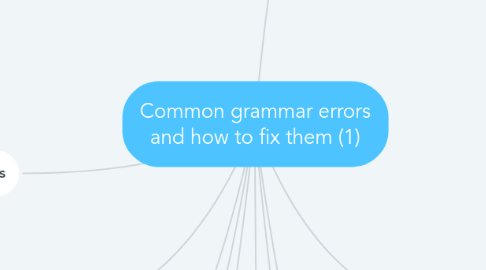Common grammar errors and how to fix them (1)
by Frances Fortes

1. Fused Principles
1.1. These occur when a write fails to use a possessive form of a noun or pronoun t introduce a gerund. Use logic to solve fused participle problems by eliminating miscues. Ask yourself where the reference ans stress should be. (e.g. Incorrect: The People objected to the defendant leaving the courtroom a free man. Correct: The People objected to the defendant's leaving the courtroom a free man.)
2. Verb Tenses and Moods
2.1. Verbs have six tenses: present, past, future, present perfect, past perfect, and future perfect.
2.2. Three moods exist in English: indicative (for statement of facts or questions), imperative (for orders or commands), and subjunctive (to express a wish, an idea contrary to fact, a requirement, or a suggestion).
3. Irregular Verbs
3.1. For most verbs, form the past tense by adding a "d" or "ed" at the end of the verb. (e.g. Talk - Talked).
3.2. Irregular verbs change a vowel and add "n" or "en"; change a vowel and add "d" or "t"; or don't change at all.
3.3. Some irregular verbs stay the same in the past tense and past participle.
4. Agreement
4.1. A verb must agree in numbers with its subjects. (e.g. Incorrect: The color of the clouds are grey. Correct: The color of the clouds is grey.)
5. Sentence Fragments
5.1. A sentence fragment is a sentence that can;t stand on its own, an incomplete sentence. It lacks a subject or a verb. (e.g. "the attorney questioning the witness")
5.2. To complete the sentence, change "questioning" from a participle to a main verb. (e.g. The attorney questioned the witness.)
6. Singular and Plural Nouns
6.1. For most nouns, add "s" to form the plural. (e.g. Bat - Bat; Window - Windows)
6.2. If the noun ends in a "y" and a consonant precedes the "y", change the "y" to "i" and add "es". (e.g. Baby - Babies). If a vowel precedes the "y", add an "s". (e.g. Alley - Alleys).
6.3. Pluralize most nouns ending in "f" by adding "s". (e.g. Proof - Proofs). Change some nouns ending in "f" or "fe" to "v" and add "es". (e.g. Elf - Elves; Knife - Knives.)
6.4. If a name ends in "f", add an "s" to form the plural.
6.5. To pluralize compound words, make the main word plural. (e.g. Attorney general - Attorneys general). If the compound word has no noun, add an "s" at the end. If the compound word ends in "ful", add and "s" at the end. (e.g. Dress-up - Dress-ups; Teaspoonful - Teaspoonfuls).
6.6. Some nouns change when they become plural. (e.g. Child - Children; Foot - Feet). Some nouns stay the same. (e.g. Deer - Deer; Fish - Fish).
6.7. Some words maintain their Latin or Greek form in the plural. (e.g. Nucleus - Nuclei; Syllabus - Syllabi)
6.8. If a noun ends in "ics" and refers to a body of knowledge, a science or a course of study, it is usually singular. (e.g. mathematics, phonetics).
6.9. Sometimes whether nouns are singular or plural depends on their meaning. (e.g. Singular: Acoustics is the study of sound. Plural: The courtroom's acoustics are poor.)
7. Pronouns
7.1. Use reflexive and intensive pronouns only to refer back to a pronoun. (e.g. Reflexive: I said that to myself. Intensive: I myself said that.)
7.2. When you write a sentence with two or more pronouns, delete the first pronoun, The ask whether the sentence reads with an "I", "me", "he", "him", "she", "her", "they", "them".
7.3. Pronouns must agree with their antecedents in gender, person, and number. (singular antecedent - singular pronoun; plural antecedent - plural pronoun)
7.4. Indefinite pronouns don't refer to any specific person or thing. (e.g. all, any, anyone, anybody, anything, each, either, etc.)
7.5. If "none" means no one or not one, the verb is singular, If "none" refers to more than one person or thing, the verb is plural.
7.6. Collective nouns in American language take a singular verb.
7.7. To determine when to use the pronouns "we" and "us", drop the noun or noun phrase before the pronoun.
8. Gerunds
8.1. A gerund is the subject or object of a verb, infinitive, or preposition that ends in "ing".
8.2. Gerund errors occur when the gerund modifies the wrong word in the sentence. Solve a gerund error in one of three ways: (1) degerundize and place the verb after the subject; (2) bifurcate the sentence; (3) subordinate.
9. Parallelism
9.1. Sentences are parallel when nouns match nouns, verbs match verbs, gerunds match gerunds, and so on. (e.g. Incorrect: A rule that is both intelligent and a necessity. Correct: A rule both intelligent and necessary.)
10. "And" vs. "To
10.1. Don't use "and" to show casuality or in an infinitive phrase. Use "to". (e.g. Incorrect: I went to the courthouse and got the judgement. Correct: I went to the courthouse to get the judgement.)


